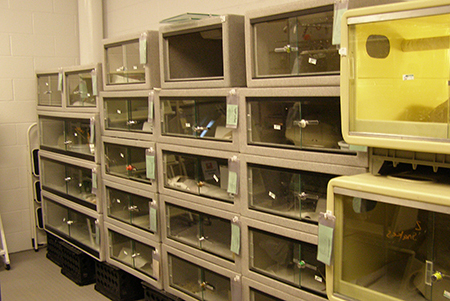

University of Nebraska–Lincoln students can obtain hands-on experience with herpetofauna at the UNL Herp Lab. Students assist Professor Ferraro in housing, feeding, caring, and treating animals in the live animal laboratory. In addition, students can participate in various research projects associated with the animals as well as gain important experience in educational events with the animals.
Blanding’s Turtle Competition Study- Caitlyn Copenhaver
I studied and compared the amount of food eaten (as a portion of total body weight) and the amount of competition between 2 juvenile and 2 adult Blanding’s turtles, as well on taking measurements on weight and plastron/carapace length and width.
American Alligator Operant Conditioning Study- Jordan Wattles
In my project I looked at 3 American alligators, a single 1-year-old, in which I conducted a growth study, and two 3-year-olds, in which I began the process of operant condition in order to support voluntary training procedures. During the operant conditioning process I had to change my approach. I originally began looking at the length of time it took for the individuals to respond to the auditory stimulus and I planned to look at how that response time changed over the project. Per Dennis’ request, I changed the project to support a quicker learning process as the individuals were associating any person interacting with them as a feeding time. I began using the auditory stimulus before feeding each individual to associate the food with noise. From there on the individuals no longer bothered others interacting with them.
Effects of Environmental Stressors on Amphibian Physiology - Danielle Galvin
I am currently a PhD candidate at the University of South Dakota. My research focuses on evaluating the effects of environmental stressors on amphibian physiology. More specifically, I am looking at how factors including temperature, drought, selenium contamination, ranavirus, Bd and ectoparasites influence amphibian overwintering physiology, development, immune function, and toxin management. In addition to research, I coordinate local herpetology outreach activities for all ages!
Spatial Ecology of the Pygmy Rattlesnake- Dylan Maag
After working with Dennis I got my M.S. in Biology at Missouri State University with Dr. Brian Greene. My thesis research was focused on the spatial ecology and habitat selection of the pygmy rattlesnake, Sistrurus miliarius. I continued my education with Dr. Rulon Clark and attended my PhD in Evolutionary Biology from San Diego State University and the University of California, Riverside. My dissertation research focuses on the behavioral and ecological mechanisms underlying differential fitness and their relationship to an individual’s ancestry using a rattlesnake hybrid system (Crotalus scutulatus x viridis).